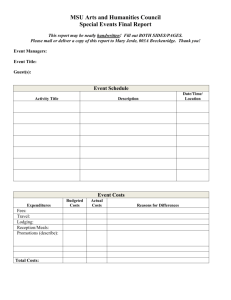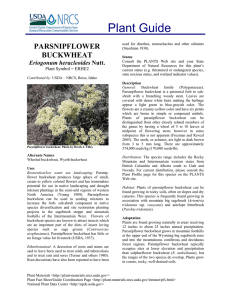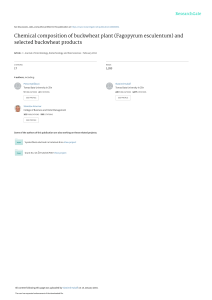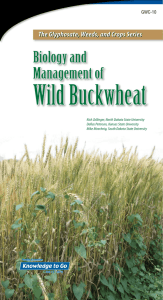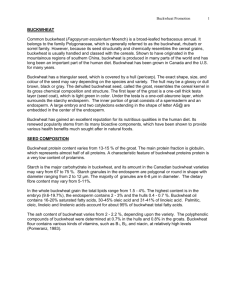Buckwheat - Michigan State University
advertisement
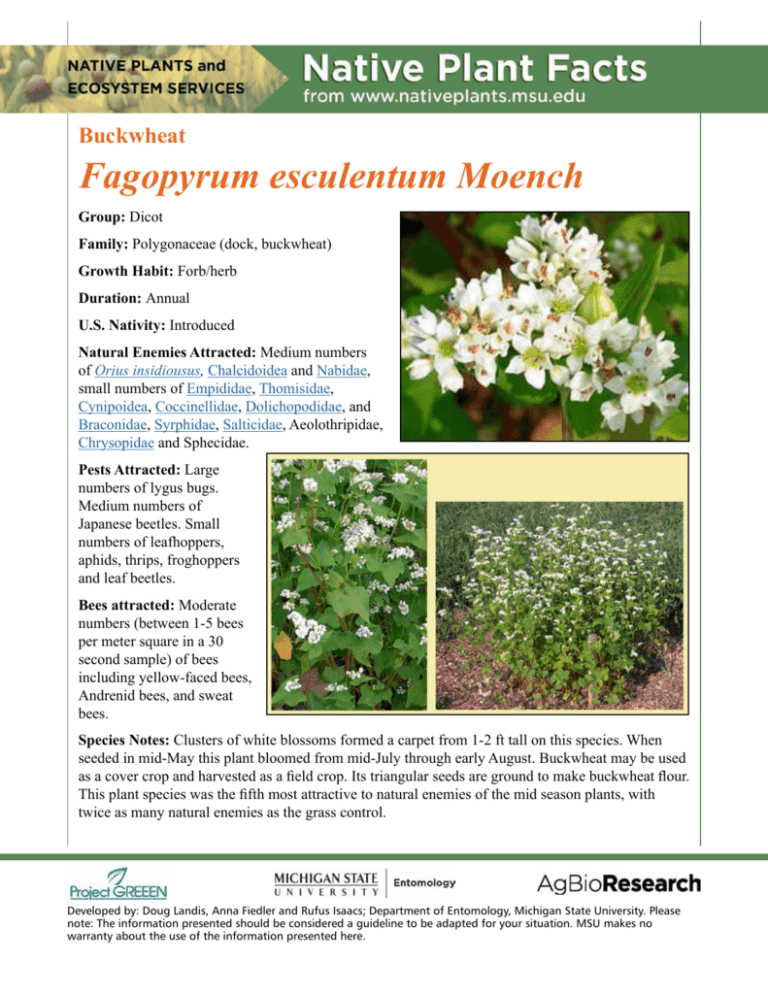
Buckwheat Fagopyrum esculentum Moench Group: Dicot Family: Polygonaceae (dock, buckwheat) Growth Habit: Forb/herb Duration: Annual U.S. Nativity: Introduced Natural Enemies Attracted: Medium numbers of Orius insidiousus, Chalcidoidea and Nabidae, small numbers of Empididae, Thomisidae, Cynipoidea, Coccinellidae, Dolichopodidae, and Braconidae, Syrphidae, Salticidae, Aeolothripidae, Chrysopidae and Sphecidae. Pests Attracted: Large numbers of lygus bugs. Medium numbers of Japanese beetles. Small numbers of leafhoppers, aphids, thrips, froghoppers and leaf beetles. Bees attracted: Moderate numbers (between 1-5 bees per meter square in a 30 second sample) of bees including yellow-faced bees, Andrenid bees, and sweat bees. Species Notes: Clusters of white blossoms formed a carpet from 1-2 ft tall on this species. When seeded in mid-May this plant bloomed from mid-July through early August. Buckwheat may be used as a cover crop and harvested as a field crop. Its triangular seeds are ground to make buckwheat flour. This plant species was the fifth most attractive to natural enemies of the mid season plants, with twice as many natural enemies as the grass control. Developed by: Doug Landis, Anna Fiedler and Rufus Isaacs; Department of Entomology, Michigan State University. Please note: The information presented should be considered a guideline to be adapted for your situation. MSU makes no warranty about the use of the information presented here. About the Plant Species Graph: Average number of beneficial insects collected at each plant species the week before, during, and after peak bloom, for plant species blooming from mid-August through early October (+ standard error). Buckwheat (Fagopyrum esculentum) boxed in red. Bars for natural enemies are in green, bars for bees are in yellow. Bars for native plants are solid and nonnative plants are striped. The black line on the top graph shows the number of natural enemies in grass with no flowering plants (grass control). Plants are listed in order of peak bloom. Plant Species Graph Habitat: Native to central Asia, requires full sun to partial sun. Grows quickly in heat, and tolerates dry periods. Volunteers in agricultural fields, successional fields, and developed land. Cultivation and Management: As an annual, flowers from seed in the first growing season. May be fall sown for earlier summer bloom. Buckwheat re-seeds, so must be mown before going to seed or will become established in the area. Although it does escape from cultivation, it is not long persistent as an escape. We saw no evidence of deer or other vertebrate browsing on this species. Availability: Species is available as seed from some seed catalogs. For more information: View the online USDA-NRCS PLANTS database MSU is an affirmative-action, equal-opportunity employer. Michigan State University Extension programs and materials are open to all without regard to race, color, national origin, gender, gender identity, religion, age, height, weight, disability, political beliefs, sexual orientation, marital status, family status or veteran status. Issued in furtherance of MSU Extension work, acts of May 8 and June 30, 1914, in cooperation with the U.S. Department of Agriculture. Thomas G. Coon, Director, MSU Extension, East Lansing,MI 48824. This information is for educational purposes only. Reference to commercial products or trade names does not imply endorsement by MSU Extension or bias against those not mentioned.




